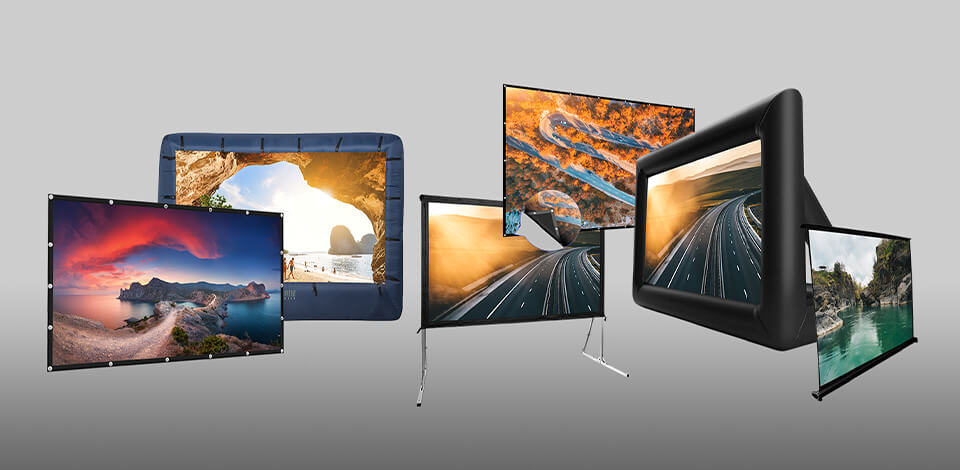
Walls can be uneven and noticeably textured, they will affect the contrast, resolution and color reproduction of the picture in a terrible way, altering the pixel geometry itself.
On the other hand, some type of projector screen can enhance the characteristics of low-contrast or low-brightness pictures by using the absorption and reflection capabilities of indoor lighting. Today, there is a vast array of screens that match your surroundings and viewing habits. The only thing for you to do is make the choice.
A projector screen is a large, reflective surface, typically light, that is positioned at a distance in front of a digital or movie projector for entertainment, learning or commercial presentations. Once you study the characteristics of your projector, such as the length of focus or power, it is time to learn how to choose projector screen.
The first step of choosing a projector screen is to think about where you will use it: outside or in the house, or perhaps everywhere? What is the mounting style, as well as the way the screens are retracted and attached? Will this be a permanent solution that can be rolled up into a casing or it can be put away for a while in the garage?
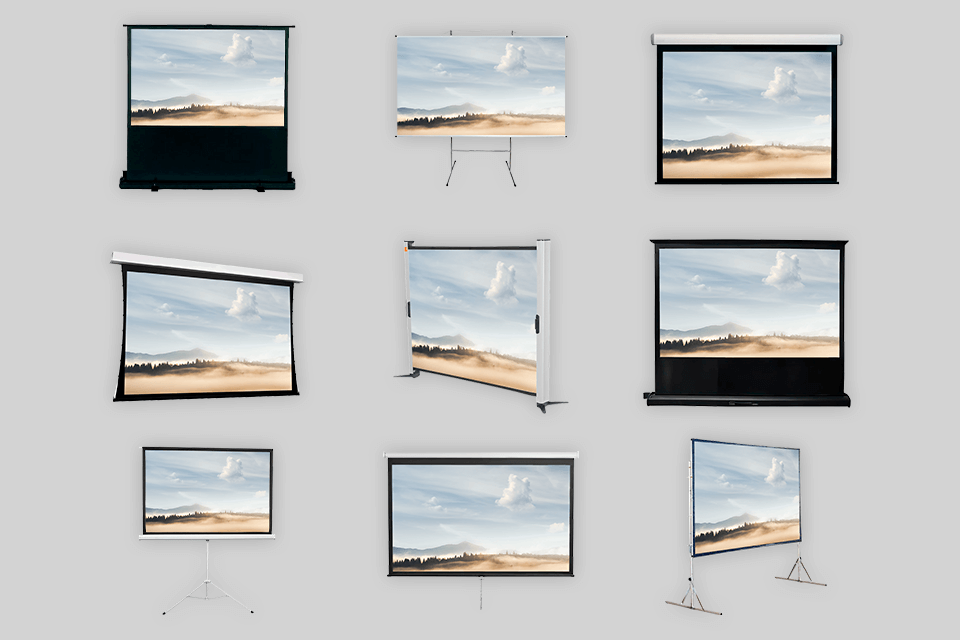
If you require a stationary installation, then opt for retractable wall mounted, ceiling mounted, floor mounted or ceiling recessed projector screens. They can be collapsed when necessary, and the casing may be used as a decorative element.
A fixed frame screen with the same placement is just as good if you don’t need to hide it. Besides, such a screen is more durable as it isn’t subject to deformation and has no electrical or moving parts.
For a portable solution, a better alternative might be tripods, floor rising, folding frame or tabletop screen. Tripods typically use a slide-out screen on a loose stand. Floor rising screens are pulled from a weighted base/drawer. Small screens for a desktop projector rise out of the case, while others extend in length and have stabilizing legs.
A folding frame is the best type of projector screen outdoors, usually consisting of several parts of an aluminum frame with a stretched screen surface that can be folded. Frames of this type must be snapped or fastened together. Some of them are retractable, other options are more portable, like mobile projector screens or inflatable screens.
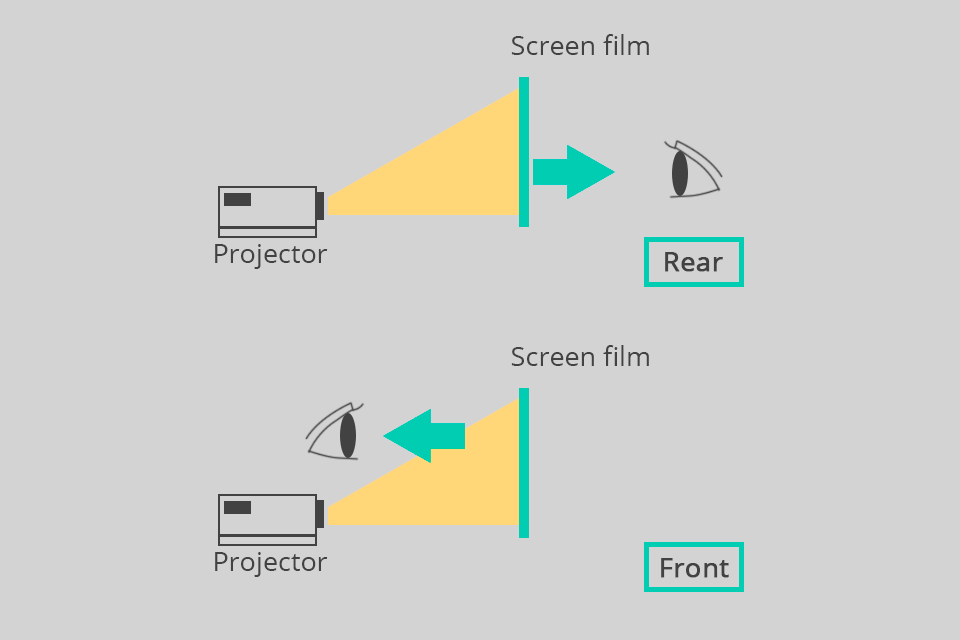
A rear projector screen offers excellent brightness, contrast and viewing angles because the projector is unobtrusively positioned behind the screen as in a TV. It projects directly into a pre-defined viewing area and doesn’t need to leave a passage for the projected light. Trapezoidal distortion correction, lens shift or zoom settings aren’t required.
With this reliable setup, you won’t have to deal with the projection factor, shadows, or people blocking the projector’s light. This is really good for working in rooms with lots of ambient light. Among the disadvantages are the need to allocate space for the projector and the fact that you will require a short throw projector – perhaps in combination with a special mirror.
The withdrawal method of retractable frames is divided into electric or manual ones. Pick one of the motorized screens with an electric drive, which is lowered and retracted by pressing a button on the remote control. Installing it is more difficult because you need to supply power to the electric motor. The electric drive is also justified with the large size and weight of the screen when manual efforts aren’t enough.
Manual pull-out screens are more accessible. They are extended and retracted into the body by a simple movement of the screen handle, which is very similar to a standard window curtain with a spring-roller mechanism. Often with a hand crank mechanism, the edge of the screen can be fixed for tension. When you remove it from the lock, the screen itself will collapse into the body.
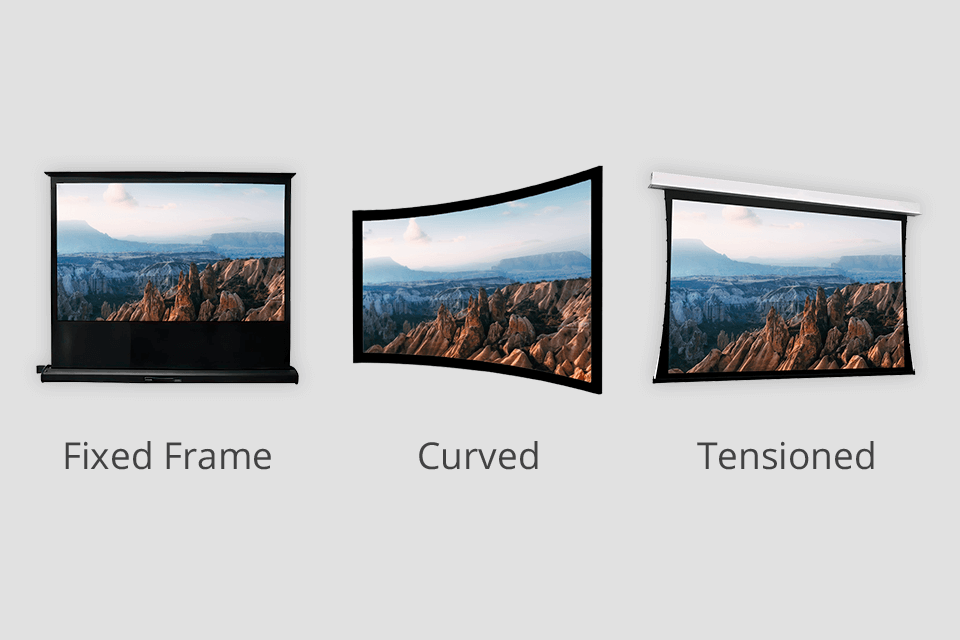
Speaking of a screen with a fixed frame, the material is stretched over a 2-3-inch metal frame covered with black velour or felt. The frame enhances the perceived contrast of the picture by absorbing the scattered light shed on the edges of the picture. It isn’t always easy to achieve a perfect filling of the picture on the screen. If part of the picture falls on the frame, its material will absorb the excess.
Some brands offer a modern design with a thin frame that mimics modern panel TVs and gives the effect of a picture floating in space. But without a thick black border, you have to be very precise when setting up the projector. Otherwise, the edges will be distorted.
The majority of retractable screens are classified as non-tensioned – the screen surface hangs freely from the housing. Minor bumps, undulations or imperfections may occur on non-stretched surfaces. High-performance screens with tension in tabs use a system of cables and protrusions to exert constant tension on the screen surface for a more even and uniform surface.
Curved fixed-frame projector screens are becoming more widespread due to the promotion of curved TVs. The curve produces the effect of covering the audience with its angles, immersing the viewer in a complete panoramic impression. However, the curved frame design offers not only aesthetic appeal. Also, it optimizes the light reflection back to the audience.
The type of projector and the way you interact with the screen here influence the choice. Pay attention to the characteristics of the projector, in particular, the projection distance, brightness, aspect ratio support and resolution. The size of the projector lens determines the size of the projected image. Don’t forget about the size of the room as well.
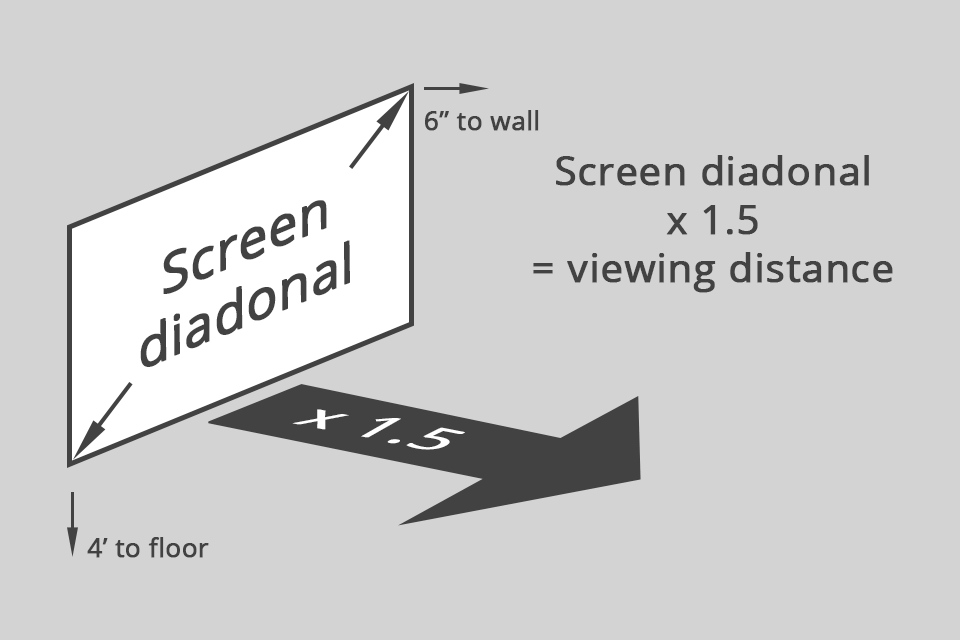
Ensure that the screen size is within the range specified in your projector’s specifications as “suggested picture size”. With the wrong screen size, you will get a picture that goes off the screen or doesn’t fill it. Stretching the picture may result in an image with suboptimal brightness or a noticeable pixel structure.
Much will depend on the throw ratio of your projector – the distance relative to the width of the screen. For instance, with a projection ratio of 1.5:1, at a distance of 15 feet, the device will project a picture 10 feet wide. Projectors with zoom lenses have a range of projection ratio, which gives you some flexibility. Many so-called setup projectors have interchangeable lenses.
For projector screen options, the limiting factor isn’t cost but space. Determine the optimal screen size based on the size of the room, the planned number of viewers, as well as the location. The height should be approximately 1/5 of the distance from the screen to the farthest viewer. Ideally, the nearest viewer should be at a distance of two screen heights from it. The screen must be set at least four feet off the floor to provide a natural viewing angle. This advice applies to a variety of projectors, including cheap projectors, as the screen size and placement considerations remain crucial for an optimal viewing experience.
Don’t miss the fact that screens, like displays of any other type, have an optical viewing angle that depends on the surface. High-gain (i.e., “brighter”) screens tend to have lower viewing angles (viewing cones) than more neutral screens, such as matte white.
To calculate the optimal viewing distance, take into account the field of view of the human eye. The SMPTE (Society of Film and Television Engineers) recommends sitting in a range where the screen fills 30° of your field of view, while THX suggests 40° for a more cinematic experience. The easiest way to calculate this distance is to multiply the screen size by 1.2 for cinematic viewing or by 1.5 for standard use.
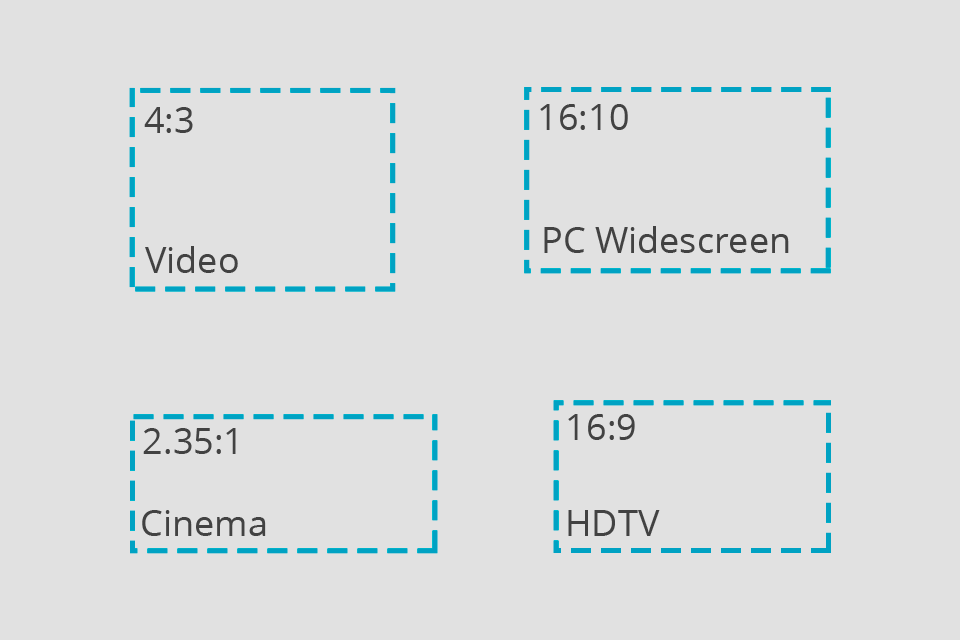
The aspect ratio of the screen is the same as in the TV and computer screen – the ratio of the width of the screen to its height. The best type of projector screen is the one that matches the original aspect ratio of your projector. To discover it, look at the highest initial resolution level of your projector. Use the calculator app or search the internet to find out the appropriate aspect ratio.
Video format projector screens have a 4:3 ratio, sometimes referred to as the NTSC format for standard television. This ratio corresponds to projectors that offer native XGA (1024×768) resolution, SXGA+ (1400×1050) resolution, UXGA (1600×1200) resolution and QXGA (2048×1536) resolution. Video format screens are ideal for switching between full-screen and widescreen viewing.
HDTV format projectors accept HDTV format projector screens with a width-to-height ratio of 16:9. They are the optimal format for home theater and widescreen viewing, being an international standard. This ratio corresponds to projectors with native resolutions of 4K UHD (3840×2160), 1080p Full HD (1920×1080) and 720p HD (1280×720). Wider options include Letterbox and Widescreen.
The 16:10 widescreen “HD-friendly” PC format is becoming more widespread with the appearance of widescreen PCs. This 16:10 aspect ratio, with some variations, matches projectors that offer native WXGA (1280×800) resolution, WSXGA+ (1680×1050) resolution, and WUXGA (1920×1200) resolution. If you plan to use only the widescreen viewing format on a PC for presentations, this may be a decent choice.
If you are searching for more possibilities to watch movies, the 2.35:1 widescreen movie standard or the anamorphic aspect ratio will suit you. Commonly used in movies as a full field of view format, the movie aspect ratio is the go-to choice if you wish to create a home theater or movie theater.
Different screen fabrics are suitable for different applications and surroundings. Their effectiveness depends on several factors, including the resolution of the media used, lighting and acoustic conditions, as well as the viewing angle of the audience. Understanding the purpose of the screen fabric and the available types simplify the choice of the optimal fabric for your screen.
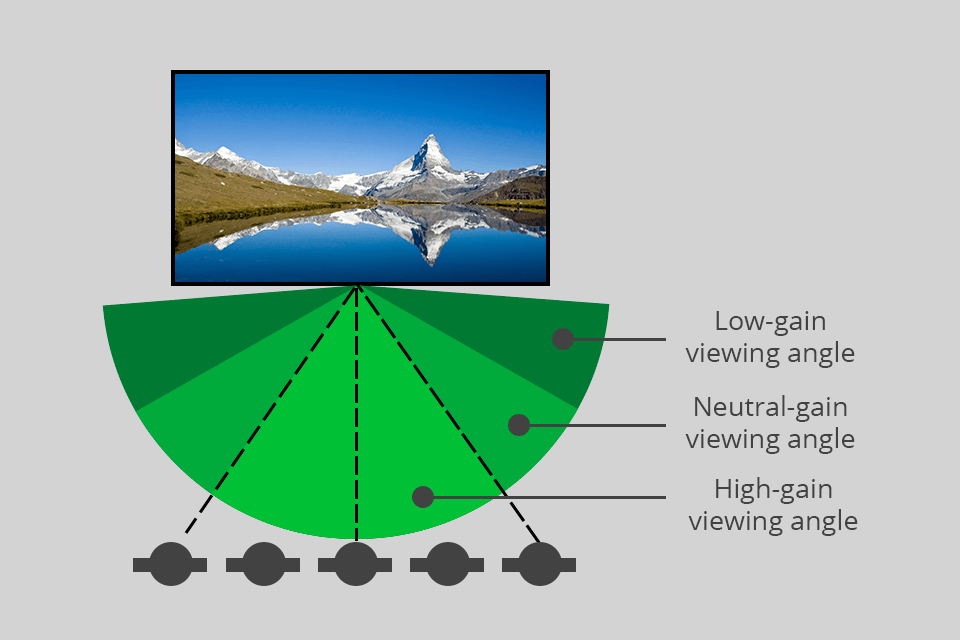
Among the most significant aspects when picking the screen fabric are gain (screen brightness) and the viewing angle of the fabric. They affect each other: as the gain increases, the viewing angle typically decreases. For most screens, finding the balance of these two factors is the primary task.
The projector screen works by reflecting the light from the projector into the audience’s eyes. The brightness of a picture reflected from a screen surface is measured in units of “gain”, measuring the light-reflecting ability of that surface.
A screen with a gain of more than 1.0 means that the image projected outside the surface is brighter than the image projected on the surface. This is achieved by focusing the light at a narrower angle of reflection instead of reflecting the light evenly in all directions. That’s why high-gain screens have a smaller viewing angle.
Viewing angle describes the maximum angle from the center of the screen at which you can still see the image without changing the quality. Some projector screens reflect most of the light perpendicular to the screen, greatly reducing it to the sides. This makes the screen darker and more distorted if the viewers aren’t at the optimal viewing angle. Unfortunately, high-gain fabrics tend to have a smaller viewing angle.
The quality of the reflected picture is affected by the amount of ambient light near the projected image. The brighter the room, the more the reflected light is scattered, causing the picture to become blurry.
In large halls where light can’t be controlled, high-gain screen fabric can compensate for the difference by increasing brightness and clarity.
Cheaper, lower-power or older projectors may not be effective at creating a bright picture in any surroundings. To compensate for this, a high-gain projector screen can increase the brightness of the picture reflected back to the audience.
It may seem that you always need more amplification – the brighter, the better. However, an excessively high gain can lead to a “hot spot” effect, where the fabric has such a high gain that it begins to exhibit mirror properties. As a result, a bright “hot spot” appears on the screen, which is an enlarged and blurred reflection of the projector lens.
A projector screen with less gain has a wider viewing angle. So, if you have a wider space, less gain will be better. Screens with less gain also help highlight a brighter black color and raise the natural contrast of the projector, preventing hot spots from appearing.
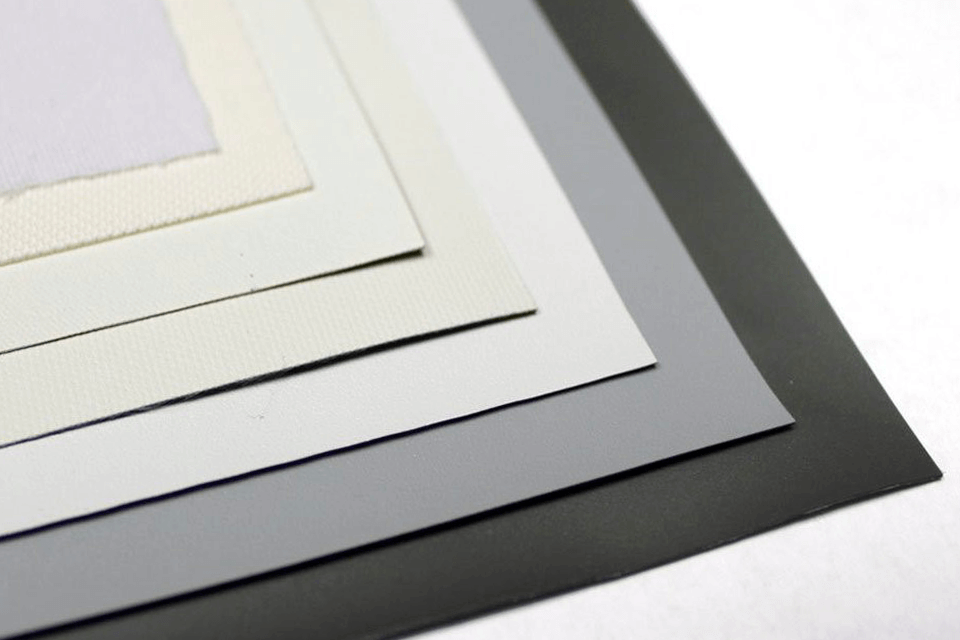
The color of the screen fabric affects the contrast of the final projected picture. Almost all projector screens feature three colors: white, gray and black. Each has its own advantages and disadvantages.
The best type of projector screen for a dark room with full light control is a white one. It will let you look at it from any angle, as most gray and black screens have a smaller viewing angle. White screens are relatively cheaper and are the industry standard for brightness. They are better suited for offices because most of the content projected in the office has a white background.
Gray screens are better at handling dark tones and controlling ambient light because they reflect less light, making it possible to use them in daylight. Modern gray screens, also called “high-contrast” screen models, often have a gain of about 1.0, which corresponds to the rating of a matte white screen but creates deeper black shades. They will also have brighter and richer colors.
Gray screens are designed for use in high-power projectors that are able to provide an adequate level of brightness to compensate for darker whites and lighter colors so that they still look like white, using the non-linear perception of brightness by the human eye. The only drawback is that depending on the surface, they may have a smaller viewing angle.
Like gray screens, black projectors don’t let in ambient light. Another outstanding feature is that black movie screens with a black surface give you the darkest shades and levels of black. The downside of black screens is that their white levels are usually somewhat less accurate.
Most projector screens are made of vinyl, high-quality plastic, spandex, rubber and polyester. You can also find ones made of PVC, canvas and fiberglass. The best projector screens are fabricated of vinyl or spandex.
Regardless of the material, it is coated with magnesium carbonate, titanium dioxide or barium sulfate to enhance the visibility of light, which is directly related to the amount of light reflected from the surface. If your room has a lot of ambient light, you will probably need a projector screen that deflects the ambient light.
Any surface that has any texture with a gradient, which exceeds the individual pixel dimensions of the projector, can disrupt and distort the pixel geometry. Therefore, the best projector screens are premium models that are properly calibrated for the high resolution of your projector, and always have the smoothest possible surface without texture.
Yes, manual pull-down screens are user-friendly. They feature a retractable design that allows the screen to be easily pulled down for use and rolled back up for storage. They are cost-effective and suitable for various settings.
Yes, inflatable projector screens are designed for outdoor use. They feature a self-inflating setup, providing a large and easily visible screen for outdoor movie nights or events.
Yes, eco-friendly projector screens are available. Some screens are made with materials that are recyclable, flame-resistant, and free from harmful chemicals, catering to environmentally conscious consumers.
Yes, many motorized screens support different aspect ratios, allowing you to adjust the screen size based on your content. This flexibility is especially useful for those who watch content in various formats.